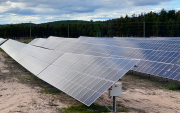Innovative local action for sustainable community economic development always inspires me. At a time when higher-level governments seem unable or unwilling to make progress toward sustainable economies, more and more local governments everywhere are assuming the helm.
Indeed, in the absence of a comprehensive renewable energy plan for Canada, several have begun forging ahead with their own long-term visions to produce renewable energy locally.
 We see this across Alberta. More than 20 communities, from Athabasca to Pincher Creek, have installed solar electricity systems on highly visible public buildings. Medicine Hat's "Hat Smart" program is helping the city's residents and businesses to cover the costs of installing solar and wind energy generation. Edmonton piloted a similar (but smaller) rebate program for solar photovoltaic systems (PV) in late 2010 - residents and businesses were so eager that the limited program was fully subscribed in very short order. Many Albertans are proud of their community's local efforts and look forward to more action.
We see this across Alberta. More than 20 communities, from Athabasca to Pincher Creek, have installed solar electricity systems on highly visible public buildings. Medicine Hat's "Hat Smart" program is helping the city's residents and businesses to cover the costs of installing solar and wind energy generation. Edmonton piloted a similar (but smaller) rebate program for solar photovoltaic systems (PV) in late 2010 - residents and businesses were so eager that the limited program was fully subscribed in very short order. Many Albertans are proud of their community's local efforts and look forward to more action.
In fact, it was at a meeting of the City of Edmonton's Task Force on Renewable Energy that we heard the story of one of the boldest municipal steps to encourage local renewable energy in North America. Gainesville, Florida - home of the Gators and Gatorade - made headlines when they launched the very first municipal feed-in tariff program to facilitate solar energy on homes and businesses.
Gainesville's story
Pegeen Hanrahan, the former mayor of Gainesville, was in Edmonton in early December to relate the successes of the city's program initiated under her tenure. In short, feed-in tariffs guarantee a price for renewable energy generation that is "fed in" to the grid. They are proliferating around the world, including recent new policies in Ontario and Nova Scotia. Feed-in tariffs are so successful they are responsible for 50 per cent of the wind energy and over 75 per cent of the solar energy constructed in the world. The policy has been found to be the most effective and proven mechanism for rapidly stimulating wide-scale renewable energy deployment at lowest cost.
In describing her community, Hanrahan painted a picture familiar to Albertans. Gainesville is an inland medium-sized centricity with a large university, surrounded by agriculture and forests. Coal fuels most of their electricity production. While Gainesville has a (much!) warmer climate than Alberta's cities, it only has about a seven per cent better solar resource for generating electricity than Edmonton does.
As Hanrahan explained, her community was grappling with some difficult energy challenges. They embarked on a unique and visionary energy journey and decided that instead of funneling money elsewhere for coal, natural gas and generated electricity, that they would pay to generate their own sustainable energy.
So, the community undertook a broad public engagement process to settle its energy woes. In 2008, Gainesville developed policies to encourage energy efficiency and conservation, to support a waste-biomass-fired generator, and, most notably, to create a feed-in tariff to encourage solar energy development.
 Gainesville's feed-in tariff guarantees a payment for 20 years for electricity fed back to the grid, set at a rate that will allow owners to recover their costs and obtain a four to five per cent rate of return. To control costs, the program is capped so that contracts are only available for four megawatts of new installed capacity each year. The first 4 MW has cost the average resident about 70¢ per month. As installation costs quickly decrease with a new, robust local solar market, future phases will cost even less.
Gainesville's feed-in tariff guarantees a payment for 20 years for electricity fed back to the grid, set at a rate that will allow owners to recover their costs and obtain a four to five per cent rate of return. To control costs, the program is capped so that contracts are only available for four megawatts of new installed capacity each year. The first 4 MW has cost the average resident about 70¢ per month. As installation costs quickly decrease with a new, robust local solar market, future phases will cost even less.
Solar systems started popping up all over the city and Hanrahan is now on a speaking tour across the continent describing the program's success.
Benefits to Gainesville
 Importantly, Gainesville has truly opened power generation ownership to broader society. Prospective owners receive contracts for generation that assures them a AA rating for obtaining financing to buy and install their solar systems.
Importantly, Gainesville has truly opened power generation ownership to broader society. Prospective owners receive contracts for generation that assures them a AA rating for obtaining financing to buy and install their solar systems.
By providing access to the grid for residents and businesses, Hanrahan says Gainesville has created economic benefits from the two-year-old program. New solar installation companies are starting up and citizens have new jobs. Local print and radio media now have solar advertising revenue. This all brings an injection of labour and capital for Gainesville.
Hanrahan speaks enthusiastically and eloquently about the pride and legacy the solar program has brought her city. Major media have covered Gainesville's endeavor and the city has attracted new business visitors and dignitaries. The program has earned Gainesville a place in tomorrow's economy, a pin on the map of global innovation, and a focused sense of community pride and place.
Lessons for home
So how does a city like Gainesville move ahead of its state and country in developing innovative clean energy programs? Hanrahan simply says the political obstacles are less daunting at the municipal level.
But she was being humble. Innovation of the type that Gainesville has pursued requires community leaders and residents with vision and motivation to start working on the sustainable economy of tomorrow. Her community will realize benefits from the solar feed-in tariff for years, even generations to come.
Gainesville shows us, though, that local governments need not sit and wait for provincial or national policy that successfully brings locally installed, owned and produced renewable energy. Other cities across North America such as Dawson Creek (B.C.), East Gwillimbury (Ontario), Medicine Hat (Alberta) and Austin (Texas), have seen action at the municipal level, the government that is closest to the people.
Gainesville has demonstrated creativity and innovation in municipal energy policy. There seems to be a buzz in municipal circles and support for action here in Alberta; it will be interesting to see how far communities can push the envelope on renewable energy.










